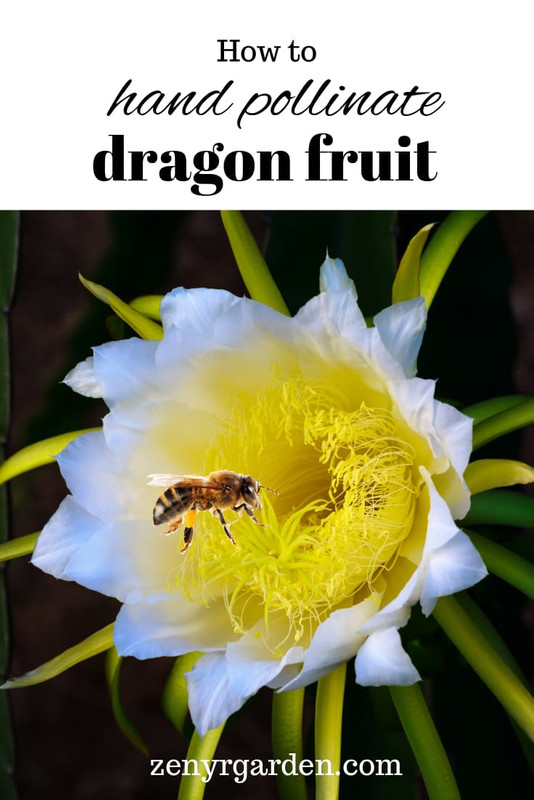While some dragon fruit varieties are self-pollinated, some other varieties may need the help of hand pollination to set fruits or get good yields. If well done, hand-pollinated dragon fruits may get bigger sizes than bee-pollinated ones. Growers have had good results with this, so let's check it out.
Our first step is:
Collect the Pollen
/pollen-of-dragon-fruit.jpg)
Dragon fruit flowers usually open at 8 pm at night & close at 8 am the next morning.
/dragon-fruit-flower-at-night.jpg)
To collect the pollen, you can use:
- A glass jar
- Nylon paint screen bags
- Scissors
/working-with-dragon-fruit-flowers-at-night.jpg)
If you use the scissors, cut off the anthers (the strings with the pollen). Then, put them in your glass jar. Alternatively, you could use a stainless steel bowl so the static charges won't affect the pollen's quality. If you store the pollen in the fridge, it can be good for up to 5 days.
/dragon-fruit-pollen-in-glass-jar.jpg)
In case you use the screen bag, wrap it around the flowers. Then, what you can do is shake the flowers so the pollen fall off & into the bag. You can collect thousands in a few hours.
Or if you want to do it the lazy way, just wrap the screen bag around the flowers & wait for them to droop quite a bit. The pollen will then naturally fall into the bag. Be quick because if we're late, bees or moths might get there first & leave us with zero pollen.
You can also use a vacuum cleaner. It's a bit loud but it gets the job done if you have lots of plants. A head lamp might be useful because you're collecting these pollen late in the day when the flowers bloom. The cool thing is dragon fruit flowers last usually only one night.
But on one plant, different flowers may open up at different times. So, the blooming show can last for 4-5 nights, with different flowers opening up here and there. The Lisa variety has a shorter bloom window than the Sugar Dragon. You can use the pollen collected on flowers that bloom earlier to pollinate the flowers that bloom later.
And now...
Let's Get to Pollinating!
With your fresh pollen, you can pollinate the dragon fruit using a paintbrush. Dip the brush into the glass jar or bag of pollen. It should have some yellow powdery stuff on the tip. Then, gently dab the brush on the stigma (the receiving female part) of the flowers.
Before 9 am the next day (after flowers bloom) is a good time to do it. Some commercial growers have had good success with this timing. You can also do the pollination later in the afternoon.
Early morning and late afternoon are the two time frames when the environmental temperature is a bit more cool. Here the stigma doesn't get dried up as much like in mid-day when it's hot. This increases the chance of the stigma being receptive to the pollen and therefore higher chances of successful pollination.
Alternatively, you can skip a step of storing the pollen by pulling the anthers off & rub them gently on the stigma right at the time you collect the pollen.
Check out the pollination of Connie Mayer red flowers which mostly need some help of hand pollination:
>> Link YouTube:
FLORAÇÃO DA PITAYA CONNIE MAYER EM VASO 11/11/19Some Pollination Ideas
Usually, folks get better results when they:
- Cross pollinate different varieties
- Freeze the pollen
Freezing the pollen is still quite controversial. Edgar Valdivia, the dragon fruit master, believes that keeping them cool is enough for viability. He doesn't recommend freezing. Other folks have good results (still viable pollen) when the pollen is frozen. You may want to experiment a bit with this to see what results you get.
Check out this awesome pollination video instructed by Edgar himself:
>> Link YouTube:
Pitahaya_Pollination_Valdivia.flvPeople often pollinate these varieties:
- White x pink/red
- Pink/red x white
- Experimental: yellow x white/red/pink
An example pair-up is the Asunta 4 with the Tricia variety to produce Asunta 5 offspring.
| Father (Pollen) | Mother (Stigma) | Offspring |
|---|---|---|
| Asunta 4 | Tricia | Asunta 5 |
The Asunta 5 is just too beautiful:
/asunta-five-dragon-fruit-flower.jpg)
But after several trials at pollinating, some folks ask:
Why Do the Pollinated Flowers Turn Yellow & Fall Off?
This may happen because we are pollinating on the same variety. The flowers don't take in that pollen & thus no fruit is formed. Doing cross pollination between different varieties will give you better results.
Pollinating with the same specie is not impossible. This guy has done it here with a red flesh dragon fruit variety. It took 3 years for him to get the first fruit:
>> Link YouTube:
Growing DRAGON FRUIT in ARIZONAAnd Off You Go Doing the Job of a Bee...
Hand pollinating is a fun & rewarding process. Ha, so this is what it's like to be doing the job of a bee. Good luck with your pollination.
Thanks to:
- Three Lucky Mountains Dragon Fruit Farm (they have great cuttings)
- Gaming TV (a dragon fruit grower)
Share or pin this post!


